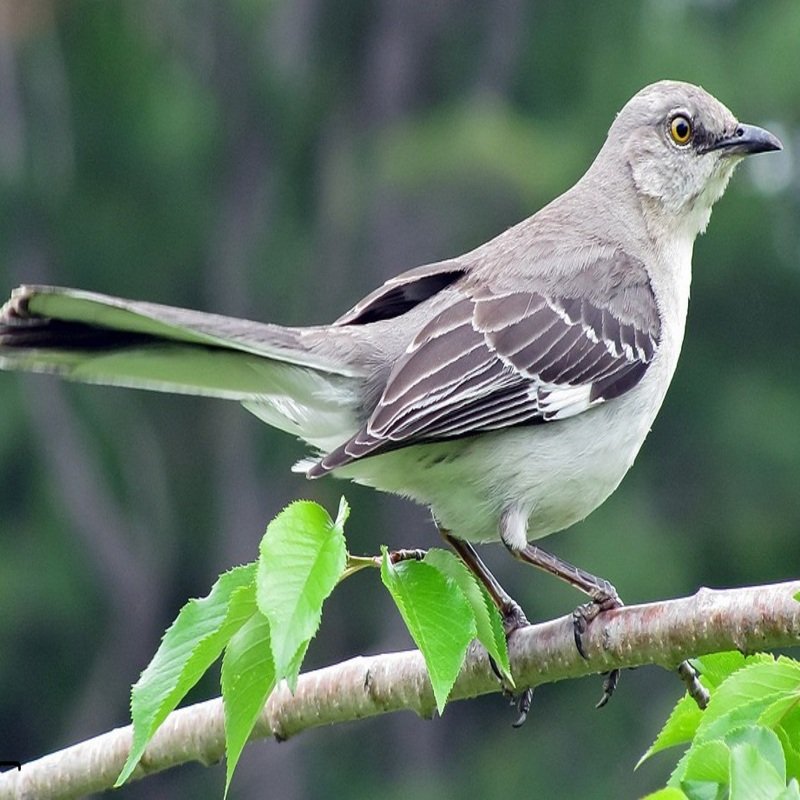Mimus polyglottos or commonly called the northern mockingbird is a North American mockingbird in the family of Mimidae. Northern birds may move south during harsh weather. This species is rare in Europe. The northern mockingbird’s scientific name, “many-tongued thrush”, refers to its mimicry ability. This bird has grayish upper feathers and a paler belly.
Quick Overview: Mimus Polyglottos – Northern Mockingbird
Body size: Around 10 in (25 cm) and a weight of 56 g (1.97 oz)
Main colors: Gray-Brown, White, Brown Range: Southern United States
Migratory Bird: No
Best time of the year to see in the U.S.: All Year (January – December)
Conservation Status: Least Concern
Northern mockingbird Description
Northern mockingbirds have long legs, tails, and short, rounded wings. It has gray-brown upperparts with large white patches on each wing, and white outer retrices in flight. Their long black bills are decurved. Males and females look alike except for size differences and females’ slightly darker tail feathers. Adults are brown with brown spots on their underparts.

Size
These birds have a length of 10 in (25 cm) and a weight of 56 g (1.97 oz). Their wings could range from 13-15 in (33-38in).
Feeding
Mockingbirds are omnivores. They eat insects, berries, and seeds. They eat beetles, ants, grasshoppers, and spiders. Their diet includes holly, mulberries, raspberries, dogwood, brambles, grapes, and figs.
Habitat
This species favors open areas and forest edges. Some common habitats include open grassy areas with thickets and brushy deserts.
Behavior
Northern mockingbirds are renowned for their beautiful singing. This species has 39 songs and 50 call notes. Northern mockingbirds can also imitate sounds like a dog barking or bird songs. These species are also known to be loners. In defense of their territory, they often attack larger animals such as cats, dogs, and humans.
Mimus polyglottos Scientific Classification
- Kingdom: Animalia
- Phylum: Arthropoda
- Subphylum: Chelicerata
- Class: Aves
- Order: Passiformes
- Family: Mimidae
- Genus: Mimus
- Species: Mimus polyglottos
Subspecies
There are three recognized subspecies for the northern mockingbird namely: M. p. polyglottos generally found in the eastern portion of North America ranging from Nova Scotia to Nebraska, to as far south as Texas and Florida, M. p. leucopterus found in the western portion of North America ranging from northwestern Nebraska and western Texas to the Pacific Coast, and south to Mexico, M. p. orpheus from the Bahamas to the Greater Antilles also the Cayman and the Virgin Islands.
Best time of the year to see
In the United States, the best time of year to see these birds is all year round, regardless of the season. This refers to any month of the year between January and December.
Distribution of the Northern mockingbird in the USA
Northern mockingbirds are found in Canada and Mexico. Sightings have been reported as far as Hawaii (where they were introduced). Northern mockingbirds are most commonly seen in Texas and southern Florida. The breeding range includes northern California, eastern Nebraska, southern Ontario, and Atlantic Canada.
The Northern mockingbird can also be found in the following states in the United States – Alabama, Alaska, Arizona, Arkansas, Colorado, Connecticut, Delaware, Georgia, Illinois, Indiana, Iowa, Kansas, Kentucky, Louisiana, Maine, Maryland, Massachusetts, Mississippi, Missouri, Nevada, New Hampshire, New Jersey, New Mexico, New York, North Carolina, Ohio, Oklahoma, Pennsylvania, Rhode Island, South Carolina, Tennessee, Utah, Vermont, Virginia, and West Virginia.

